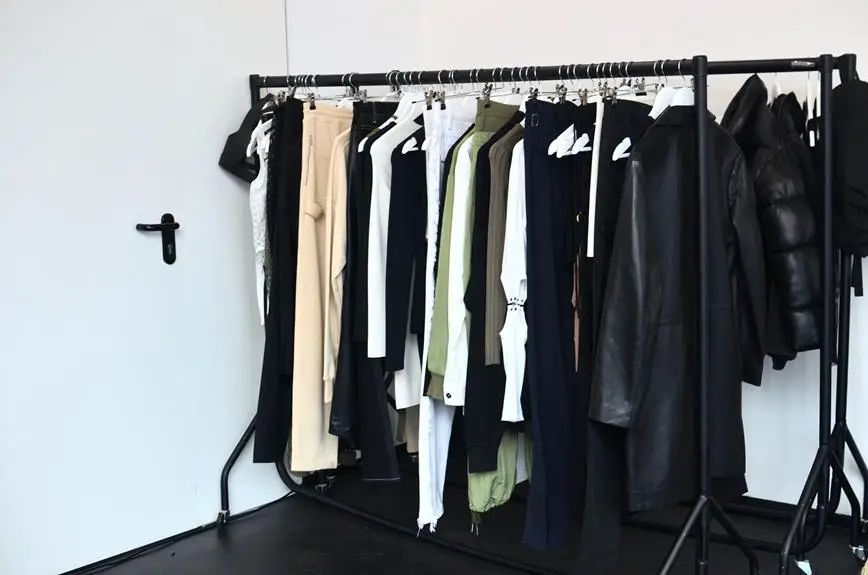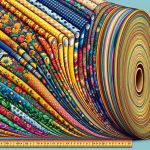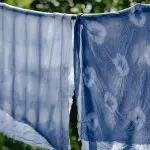You might be wondering, 'What size fabrics do I need for making a dress?'
Understanding the right fabric sizing is crucial for creating a well-fitting and stylish garment. Whether you're a seasoned seamstress or just starting out, mastering the art of choosing the correct fabric yardage for your dress projects is essential.
Factors like dress style, size, and fabric width all play a role in determining the amount of fabric needed. In this guide, we'll delve into the intricacies of fabric yardage, explore the influences on fabric requirements, and provide tips for efficiently purchasing the right amount of fabric for your next dressmaking endeavor.
Key Takeaways
- Calculate fabric yardage based on measurements and pattern's suggested fabric width
- Consider fabric weight for drape and structure
- Account for pattern complexity and directional prints
- Ensure enough yardage for a flawless finished product
Understanding Fabric Yardage
You will need to calculate the exact fabric yardage required for your dress based on your measurements and the pattern's suggested fabric width.
Understanding fabric weight is essential in determining the drape and structure of your dress. Lightweight fabrics are great for flowy designs, while heavier fabrics are better suited for structured styles.
Consider the pattern complexity as well. Intricate patterns or designs with directional prints may require additional yardage to ensure pattern matching and layout.
When selecting your fabric, take into account the pattern's suggested fabric width. This will impact the amount of yardage needed for your specific size.
It's crucial to add extra yardage for any adjustments, pattern matching, or creating additional design elements.
Once you've considered the fabric weight and pattern complexity, you can accurately calculate the yardage needed for your dress, ensuring you have enough for a flawless finished product.
Mastering these calculations will empower you to confidently choose the perfect fabric for your dress, bringing your vision to life with precision and expertise.
Factors Influencing Fabric Requirements
To accurately determine fabric requirements for your dress, carefully consider the pattern's suggested fabric width and the complexity of the design, ensuring you have enough yardage for a flawless finished product. Additionally, take into account the fabric weight. The weight of the fabric significantly influences the drape and structure of the garment.
When choosing fabric for your dress, keep in mind the following factors:
- Fabric Weight: Consider the season and occasion for which the dress is intended. Lighter weight fabrics such as chiffon and silk are ideal for airy, flowing designs, while heavier fabrics like wool or denim provide structure and warmth.
- Pattern Matching: When working with patterned fabric, the design complexity may influence the required yardage. Intricate patterns or directional prints often necessitate more fabric to ensure seamless pattern matching, especially for garments with princess seams or intricate design details.
- Adverb of Frequency: The frequency with which a pattern repeats can impact the amount of fabric needed. A higher frequency may require additional yardage to match patterns across seams and garment sections accurately.
Considering these factors will ensure that you have the right amount and type of fabric for your dress, resulting in a well-structured and visually appealing garment.
Fabric Sizing for Different Dress Styles
Considering the factors discussed in the previous section, fabric sizing for different dress styles varies based on the design complexity and desired fabric weight. The weight of the fabric is crucial in achieving the desired drape, structure, and overall look of the dress. Lighter fabrics such as chiffon and organza are ideal for flowy, ethereal designs, while heavier fabrics like wool and denim work well for structured or tailored dresses. Pattern matching is also an important consideration when determining fabric sizing, especially for styles with intricate patterns or designs that require seamless continuity. Here's a helpful table to guide you in choosing the right fabric size for different dress styles:
| Dress Style | Fabric Weight | Fabric Size Recommendation |
|---|---|---|
| Flowy Maxi Dress | Lightweight | 3-4 yards |
| Structured Blazer | Medium to Heavy | 2-3 yards |
| Fit and Flare | Medium | 2-3 yards |
| A-line Dress | Medium to Heavy | 2-3 yards |
Understanding the relationship between fabric weight, pattern matching, and dress style will enable you to make informed decisions when selecting fabrics for your dressmaking projects.
Calculating Fabric Needs for Various Sizes
When determining the fabric needs for various sizes, it's important to factor in the specific measurements and design requirements of the dress style you're working with. Calculating measurements accurately is key to ensuring you have enough fabric for the dress size you're making.
Here are some key points to consider when calculating fabric needs for various sizes:
- Adjusting Patterns:
- Take into account the pattern's size range and make adjustments as needed for different sizes.
- Consider the length and width of the fabric when adjusting patterns to accommodate larger sizes.
- Factor in any design details, such as ruffles or pleats, that may require additional fabric for larger sizes.
By carefully considering these factors, you can ensure that you have the right amount of fabric to create a well-fitted dress in any size.
Remember to always double-check your calculations and measurements to avoid running out of fabric mid-project.
Tips for Efficient Fabric Purchasing
When purchasing fabric for your dress, carefully plan and measure to ensure you buy the right amount for your project.
Choosing the right fabric is crucial for a successful dressmaking project. Consider the weight, drape, and stretch of the fabric to ensure it suits the dress design and complements your body type.
Before heading to the fabric store, make a list of the materials you need based on your measurements and the dress pattern. Maximizing yardage efficiency is key to efficient fabric purchasing. Look for patterns that allow for efficient cutting, such as ones with simple silhouettes or straight lines.
Additionally, consider using the same fabric for lining and outer layers to reduce waste and save money.
When buying fabric, it's wise to purchase a little extra to allow for any mistakes or modifications. However, avoid buying too much excess fabric as it can lead to unnecessary waste.
Frequently Asked Questions
Can I Use Different Sized Fabrics for the Bodice and Skirt of a Dress?
You can absolutely use different sized fabrics for the bodice and skirt of a dress. This allows for fabric compatibility and design flexibility, making pattern mixing and fabric manipulation a creative way to add interest to your dress design.
How Much Extra Fabric Should I Buy for Pattern Matching or Directional Prints?
When working with directional prints, it's crucial to buy extra fabric for pattern matching and fabric layout. This ensures minimal fabric wastage and a polished final look. Careful planning and attention to detail will yield professional results.
Are There Any Specific Fabric Requirements for Making a Dress With a Lining?
When making a dress with a lining, consider fabric selection for both the dress and lining. Opt for lightweight fabrics like chiffon or satin for the lining to add structure and flow to your dress construction.
What Is the Best Way to Estimate Fabric Needs for Dresses With Embellishments or Intricate Details?
To estimate fabric needs for an embellished dress, consider the design elements and adjust for one-way patterns. For intricate details, add extra fabric for seam allowances. When adding a lining, calculate fabric requirements for both the dress and the lining fabric.
Are There Any Tips for Adjusting Fabric Requirements When Using Fabric With a Nap or One-Way Design?
When adjusting pattern for fabric with nap or one-way design, ensure to lay out pieces in the same direction. Remember to add extra yardage to accommodate the nap. Be mindful of fabric direction to achieve a cohesive look.
- DIY Ombre Tie-Dye: A Simple Guide for a Faded Look - July 13, 2025
- Ombre Tie-Dye Technique: How to Create a Gradient Effect - July 13, 2025
- How to Do the Crumple Tie-Dye Technique: A Step-by-Step Tutorial - July 13, 2025






